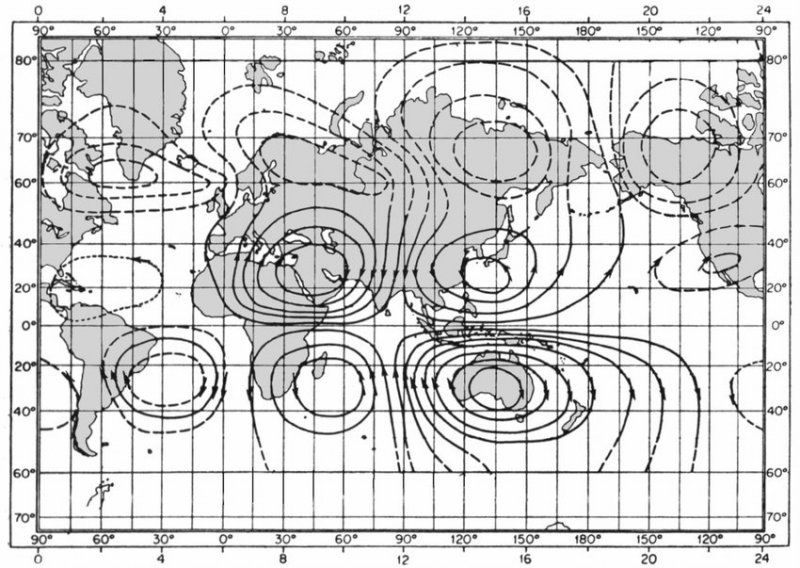テルリック電流(地電流)は、地球の地殻や海洋を通って流れる自然発生の電流です。太陽活動や雷の落雷などの外部の電磁エネルギーと地球の磁場の相互作用など、さまざまな要素によって生じます。
テルリック電流は、一般的には低周波の交流電流であり、岩石、鉱物、水などの地球の地殻内の導電性物質を通じて長距離にわたって流れることがあります。これらの電流は、土壌の構成、含水率、鉱物の存在などによって変動する地面の導電性に影響を受けます。
テルリック電流の主要な源は、地球の磁場と太陽放射によってイオン化された大気の一部であるイオノスフィアとの相互作用です。この相互作用により、イオノスフィアで電流が生成され、電磁誘導というプロセスを通じて地表面に電流が誘起されます。
テルリック電流は、地表面付近を水平に流れ、最も抵抗の少ない経路をたどることが観察されています。また、断層線や地下構造などの地質学的な特徴も、電流の導体として機能することがあります。
テルリック電流の強度は、地球の地磁気活動、地面の局所的な導電性、外部の電磁エネルギーの存在など、さまざまな要素によって異なります。一部の場合、感度の高い計器を用いて検出および測定可能なレベルまでテルリック電流が到達することもあります。
テルリック電流は、地球物理学、地質学、電気工学などさまざまな分野に影響を与えます。感度の高い電子機器や送電システムの運用に影響を及ぼすことがあります。また、テルリック電流は、磁場を利用して航行する動物の行動など、自然システムにも影響を与えることがあります。
テルリック電流の研究と理解は、地球科学のさまざまな分野において重要です。磁力計や地面導電度計などの特殊な計器を使用してテルリック電流の流れを測定し、マッピングすることが研究者によって行われます。この知識は、電気システムの設計と運用の改善、地質構造の調査、地球の複雑な電磁環境に関する理解の向上に役立てることができます。
Telluric currents, also known as Earth currents, are natural electric currents that flow through the Earth’s crust and oceans. They are a result of various factors, including the interaction between the Earth’s magnetic field and external sources of electromagnetic energy, such as solar activity and lightning strikes.
Telluric currents are generally low-frequency alternating currents that can travel for long distances through conductive materials in the Earth’s crust, such as rocks, minerals, and bodies of water. These currents are influenced by the conductivity of the ground, which varies depending on factors like soil composition, moisture content, and the presence of minerals.
The primary source of telluric currents is the interaction between the Earth’s magnetic field and the ionosphere, a layer of the Earth’s atmosphere that is ionized by solar radiation. This interaction generates electric currents in the ionosphere, which then induce currents in the Earth’s surface through a process known as electromagnetic induction.
Telluric currents have been observed to flow horizontally near the Earth’s surface, following the path of least resistance. They can also be influenced by geological features, such as fault lines and underground structures, which can act as conduits for the currents.
The strength of telluric currents can vary depending on several factors, including the geomagnetic activity of the Earth, the local conductivity of the ground, and the presence of external sources of electromagnetic energy. In certain cases, telluric currents can reach levels that are detectable and measurable using sensitive instruments.
Telluric currents have implications in various fields, including geophysics, geology, and electrical engineering. They can affect the operation of sensitive electronic equipment and power transmission systems. In some cases, telluric currents can also have an impact on natural systems, such as the behavior of animals that rely on magnetic fields for navigation.
Studying and understanding telluric currents is important for various scientific and practical applications. Researchers use specialized instruments, such as magnetometers and ground conductivity meters, to measure and map the flow of telluric currents. This knowledge can be utilized to improve the design and operation of electrical systems, investigate geological structures, and further our understanding of Earth’s complex electromagnetic environment.
Telluric currents are phenomena observed in the Earth’s crust and mantle. In September 1862, an experiment to specifically address Earth currents was carried out in the Munich Alps (Lamont, 1862).[2] Including minor processes, there are at least 32 different mechanisms which cause telluric currents.[3] The strongest are primarily geomagnetically induced currents, which are induced by changes in the outer part of the Earth’s magnetic field, which are usually caused by interactions between the solar wind and the magnetosphere or solar radiation effects on the ionosphere. Telluric currents flow in the surface layers of the earth. The electric potential on the Earth’s surface can be measured at different points, enabling the calculation of the magnitudes and directions of the telluric currents and hence the Earth’s conductance. These currents are known to have diurnal characteristics wherein the general direction of flow is towards the sun.[4][5] Telluric currents continuously move between the sunlit and shadowed sides of the earth, toward the equator on the side of the earth facing the sun (that is, during the day), and toward the poles on the night side of the planet.
Both telluric and magnetotelluric methods are used for exploring the structure beneath the Earth’s surface (such as in industrial prospecting). For mineral exploration the targets are any subsurface structures with a distinguishable resistance in comparison to its surroundings. Uses include geothermal exploration, mining exploration, petroleum exploration, mapping of fault zones, ground water exploration and monitoring, investigation of magma chambers, and investigation of boundaries of tectonic plates. Earth batteries tap a useful low voltage current from telluric currents and were used for telegraph systems as far back as the 1840s.[6]
